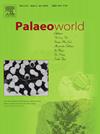High-precision age constraint for the Xiyingzi Bed of the Jiufotang Formation in western Liaoning, Northeast China
IF 1.7
3区 地球科学
Q2 PALEONTOLOGY
引用次数: 0
Abstract
The Jehol Biota includes exceptionally well-preserved fossils that are major components of Early Cretaceous land ecosystems. The youngest example of the Jehol Biota occurs in the Jiufotang Formation, which potentially records palaeoenvironmental factors triggering evolutionary turnover. However, the lack of stratigraphic correlations and uncertain age horizons for many fossil taxa lead to conflicting interpretations of events. This study describes a new significant fossiliferous bed (Xiyingzi Bed) from the upper Jiufotang Formation of the Baomayingzi-Yuanjiawa outcrop in western Liaoning, Northeast China. High-precision CA-ID-TIMS U-Pb analysis of a tuff sample from the Xiyingzi Bed provides an age of 121.272 ± 0.040/0.068/0.15 Ma, representing the first reliable age for the upper Jiufotang Formation in western Liaoning.
Vertebrate fossils preliminarily reported from this bed include the confuciusornithid and enantiornithine birds, the istiodactylid pterosaur, the non-hadrosaurid iguanodontian dinosaur, the long-necked choristoderan reptiles, the sinemydid turtles, and the polyodontid and sinamiid fish. These fossils were previously reported from the lower horizons, indicating stable development of the late Jehol Biota. New results from the Xiyingzi Bed provides a glimpse of the late Jehol biota before transforming into a typical mid-Cretaceous biota in western Liaoning. Systematic biostratigraphic and chronostratigraphic analysis of the Xiyingzi Bed helps the evolutionary interpretations of the late Jehol Biota and the correlation of the Jiufotang Formation within different basins of western Liaoning.
辽西地区九佛塘组西营子层高精度年龄约束
热河生物群包括保存非常完好的化石,是早白垩纪陆地生态系统的主要组成部分。热河生物群最年轻的例子出现在九佛堂组,它可能记录了引发进化更替的古环境因素。然而,许多化石分类群缺乏地层相关性和不确定的年龄范围导致对事件的相互矛盾的解释。本文描述了辽西地区宝马营子—元家洼露头九佛堂组上段一个新的重要化石层(西营子层)。对西营子层凝灰岩样品进行高精度CA-ID-TIMS U-Pb分析,确定了其年龄(121.272±0.040/0.068/0.15 Ma),为辽西上九福塘组提供了第一个可靠的年龄。初步报道的脊椎动物化石包括:孔子鸟目和反鸟目鸟类、正手纲翼龙、非鸭嘴龙禽龙、长颈脉管纲爬行动物、鳖类、多齿目和鱼类。这些化石以前在较低的层位报道过,表明热河生物群晚期发育稳定。西营子地层的最新研究结果揭示了辽西地区热河晚期生物群转变为典型的中白垩世生物群之前的情况。对西营子地层进行系统的生物地层学和年代学分析,有助于辽西不同盆地热河晚期生物群的演化解释和九佛堂组的对比。
本文章由计算机程序翻译,如有差异,请以英文原文为准。
求助全文
约1分钟内获得全文
求助全文
来源期刊

Palaeoworld
PALEONTOLOGY-
CiteScore
4.00
自引率
5.90%
发文量
95
期刊介绍:
Palaeoworld is a peer-reviewed quarterly journal dedicated to the study of past life and its environment. We encourage submission of original manuscripts on all aspects of palaeontology and stratigraphy, comparisons of regional and global data in time and space, and results generated by interdisciplinary investigations in related fields. Some issues will be devoted entirely to a special theme whereas others will be composed of contributed articles. Palaeoworld is dedicated to serving a broad spectrum of geoscientists and palaeobiologists as well as serving as a resource for students in fields as diverse as palaeobiology, evolutionary biology, taxonomy and phylogeny, geobiology, historical geology, and palaeoenvironment.
Palaeoworld publishes original articles in the following areas:
•Phylogeny and taxonomic studies of all fossil groups
•Biostratigraphy, chemostratigraphy, chronostratigraphy
•Palaeoecology, palaeoenvironment and global changes throughout Earth history
•Tempo and mode of biological evolution
•Biological events in Earth history (e.g., extinctions, radiations)
•Ecosystem evolution
•Geobiology and molecular palaeobiology
•Palaeontological and stratigraphic methods
•Interdisciplinary studies focusing on fossils and strata
 求助内容:
求助内容: 应助结果提醒方式:
应助结果提醒方式:


